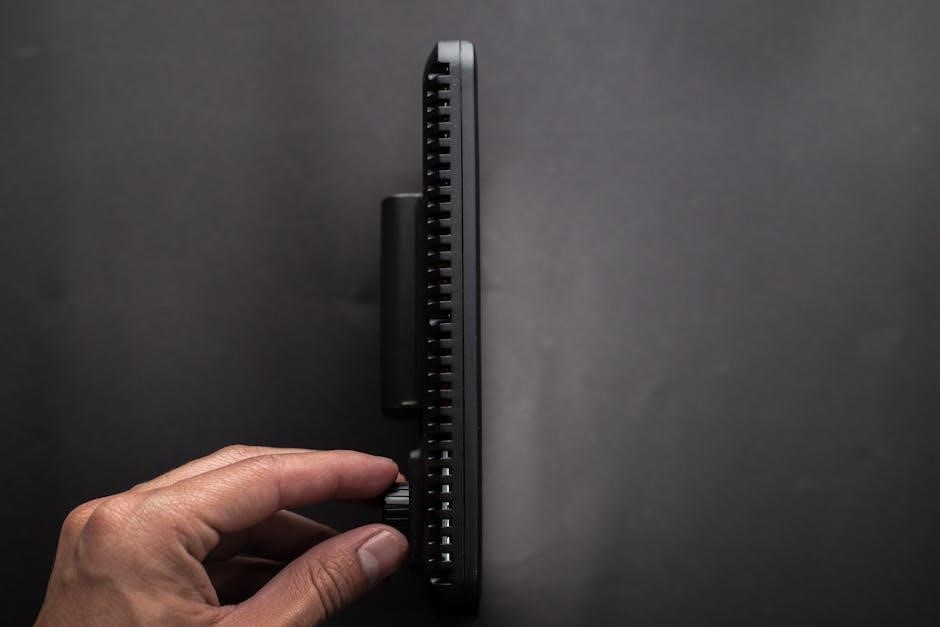A manual slack adjuster is a critical component in air brake systems, ensuring proper clearance between brake pads and drums for efficient braking performance and safety.
1.1 Definition and Purpose
A manual slack adjuster is a mechanical component in air brake systems used to regulate the clearance between brake pads and drums. Its primary purpose is to ensure efficient braking by maintaining proper alignment and engagement of brake components. By adjusting the slack, it compensates for wear on brake linings, ensuring consistent stopping performance. This component is essential for safety in heavy-duty vehicles, as improper adjustment can lead to reduced braking efficiency and potential accidents. Regular maintenance is crucial to uphold its functionality and reliability in demanding operational conditions.
1.2 Importance in Truck and Trailer Braking Systems
Manual slack adjusters play a vital role in ensuring the safety and efficiency of truck and trailer braking systems. They maintain proper brake function by compensating for wear on brake linings, ensuring consistent stopping performance. Improperly adjusted slack can lead to reduced braking efficiency, posing significant safety risks. Regular adjustment prevents excessive slack, which can cause brakes to fail or overheat. This component is critical for maintaining control during emergencies and adhering to safety regulations. Its reliability directly impacts vehicle stability, making it indispensable for heavy-duty applications and ensuring safe operation on the road.

How Manual Slack Adjusters Work
Manual slack adjusters regulate brake components using a worm and gear mechanism, ensuring proper engagement of brake pads and drums for safe and efficient stopping.
2.1 Basic Principles of Operation
Manual slack adjusters function by converting air pressure into mechanical force, pushing the pushrod outward. This motion rotates the S-cam shaft, applying torque to the brake shoes. The worm and gear mechanism in the adjuster compensates for wear on the brake linings, ensuring consistent braking performance. Proper adjustment is crucial to maintain optimal clearance between the brake pads and drums, preventing excessive wear and ensuring reliable stopping power. Regular maintenance, such as lubrication and inspection, is essential to uphold the adjuster’s functionality and safety standards in truck and trailer braking systems.
2.2 Role in Air Brake Systems
Manual slack adjusters are essential in air brake systems, ensuring proper brake stroke and efficient engagement of brake pads with drums. They function by converting air pressure into mechanical force, pushing the pushrod outward to rotate the S-cam shaft. This motion applies torque to the brake shoes, enabling reliable stopping power. The adjuster compensates for brake lining wear, maintaining consistent performance. Proper adjustment is critical to prevent excessive wear and ensure safety. Regular maintenance, such as lubrication and inspection, is vital to uphold the adjuster’s functionality and overall braking system integrity in trucks and trailers.
2.3 Mechanical Components and Their Functions
A manual slack adjuster consists of a worm and gear mechanism, pushrod clevis, and S-cam shaft. The worm and gear enable manual adjustment, while the pushrod clevis connects to the air cylinder. The S-cam shaft applies torque to the brake shoes, initiating braking. Return springs ensure the shoes retract after braking. These components work together to maintain proper brake clearance and ensure efficient braking performance in air brake systems.
Types of Slack Adjusters
Slack adjusters are available in manual and automatic types, with varying configurations, torque ratings, and spline counts, catering to different vehicle specifications and braking requirements.
3.1 Manual vs. Automatic Slack Adjusters
Manual slack adjusters require hands-on adjustment using tools, ensuring proper brake engagement by compensating for wear. Automatic slack adjusters self-regulate, maintaining optimal clearance without manual intervention, enhancing efficiency and reducing maintenance needs while ensuring consistent braking performance across various driving conditions; Both types are designed to maintain proper brake function, but automation offers convenience and reliability, making automatic slack adjusters increasingly popular in modern vehicles. Manual adjusters are often found in older or specialized equipment, necessitating regular checks and adjustments to uphold safety standards and operational efficiency.
3.2 Different Models and Configurations
Manual slack adjusters are available in various models and configurations to suit different braking needs. Common configurations include 1-hole, 3-hole, and 4-hole setups, each designed for specific applications. Models like the Bendix 279350 and Haldex automatic slack adjusters offer unique features, with spline counts ranging from 10 to 33 and arm lengths varying between 4.5 to 8 inches. These configurations ensure compatibility with diverse brake systems, torque requirements, and vehicle types, including trucks, buses, and trailers. Additionally, riveted and non-riveted types cater to different installation preferences, providing flexibility for maintain optimal braking performance across various operational demands.
3.3 Arm Configurations and Torque Ratings
Manual slack adjusters feature varying arm configurations and torque ratings to accommodate different braking demands. Common arm lengths range from 4.5 to 8 inches, ensuring compatibility with diverse brake systems. Torque ratings vary from 100 to 400 ft-lbs, depending on application requirements. These configurations are designed to optimize braking performance and durability for specific vehicle types, such as heavy-duty trucks or urban buses. Proper alignment and torque settings are crucial for maintaining effective braking control and preventing wear on related components. Arm configurations and torque ratings are selected based on vehicle weight, braking frequency, and operational conditions to ensure safety and reliability.
Adjustment Process
The manual slack adjuster adjustment process involves marking the push rod, loosening the locknut, adjusting the bolt to the desired torque, and retightening the locknut to ensure proper clearance and braking efficiency.
4.1 Step-by-Step Guide to Adjusting Manual Slack Adjusters
Ensure the truck or trailer is on level ground and apply chocks to the wheels for safety.
Release the parking brakes and build air pressure to over 100 PSI.
Locate the manual slack adjuster and loosen the locknut using a wrench.
Turn the adjusting bolt clockwise to tighten the slack adjuster until resistance is felt.
Mark the push rod at the brake chamber with the brakes released and again after a full application.
Adjust the bolt to achieve the correct clearance, ensuring proper braking efficiency.
Tighten the locknut securely and test the brakes to confirm proper adjustment.
This process ensures optimal braking performance and safety, preventing excessive wear or brake failure.
4.2 Tools and Equipment Required
To adjust manual slack adjusters, essential tools include a wrench or socket set for loosening locknuts and turning adjusting bolts. A chocking device is necessary to secure the vehicle, ensuring safety during adjustments. Air pressure gauges are required to verify proper system pressure, typically over 100 PSI. Marking tools, such as chalk or a marker, help measure push rod movement. Wheel chocks and jack stands provide stability, while gloves and safety glasses protect the technician. These tools ensure accurate and safe adjustments, maintaining optimal braking performance and compliance with safety standards.
4.3 Safety Precautions During Adjustment
Always chock the wheels and engage the parking brake before starting adjustments. Wear protective gear, including gloves and safety glasses, to prevent injury. Ensure the vehicle is on level ground and supported by jack stands if lifted. Never adjust brakes under a loaded vehicle or while it is in motion. Apply the service brakes fully to ensure proper system pressure, typically above 100 PSI. Avoid over-tightening, as this can damage components or compromise braking efficiency. Follow proper locknut tightening procedures to maintain safety and performance. Always refer to the manufacturer’s guidelines for specific instructions.
Maintenance and Inspection
Regular lubrication of moving parts every six months ensures smooth operation. Inspect for wear, cracks, or excessive play, and clean components to maintain optimal braking efficiency always.
5.1 Regular Maintenance Requirements
Regular maintenance ensures optimal performance and safety. Lubricate pivot points and internal gears every six months with high-quality grease. Inspect for wear, corrosion, or damage regularly. Clean debris from the adjuster and surrounding areas to prevent interference. Check for proper alignment and torque settings as specified. Replace worn or damaged components immediately to avoid brake system failure. Maintain proper clearance between the brake pads and drums by adjusting as needed. Keep records of all maintenance activities for compliance and tracking purposes.
5.2 Signs of Wear and Tear
Signs of wear and tear on manual slack adjusters include excessive play in the pivot points, rust or corrosion on moving parts, and worn or rounded splines. Grease contamination or leakage from the adjuster indicates seal failure. Visible damage to the arm, clevis, or threads suggests misuse or over-tightening. Increased brake pedal effort or spongy feel may signal internal wear. Regular inspections can identify these issues early, preventing further damage to the braking system and ensuring safety on the road. Addressing wear promptly maintains braking efficiency and avoids potential failures during operation.
5.3 Lubrication Intervals and Procedures
Regular lubrication of manual slack adjusters is essential to maintain smooth operation and prevent wear. Apply high-temperature grease to pivot points and splines every 12,000 to 15,000 miles or as specified by the manufacturer. Clean old grease and debris before reapplying to ensure proper lubrication. Over-lubrication can attract dirt, so use the recommended amount. For heavy-duty or high-temperature applications, lubricate more frequently, such as every 6,000 miles. Always refer to the manufacturer’s guidelines to avoid under or over-lubrication, which can lead to premature wear or failure of the adjuster.
Common Issues and Solutions
Common issues include improper adjustment, wear, and lubrication problems. Solutions involve proper adjustment techniques, regular lubrication, and timely replacement of worn components to ensure optimal performance.
6.1 Improper Adjustment and Its Consequences
Improper adjustment of manual slack adjusters can lead to excessive wear on brake components, reduced braking efficiency, and increased stopping distances. If the slack is too loose, brakes may drag, causing overheating and premature wear. Conversely, too tight a setting can delay brake engagement, compromising safety. Misadjustment can also result in non-compliance with federal regulations, leading to fines or vehicle removal from service. Regular inspection and correct adjustment are critical to maintaining optimal braking performance and ensuring compliance with safety standards. Proper training is essential to avoid these issues and their potentially severe consequences.
6.2 Troubleshooting Common Problems
Common issues with manual slack adjusters include excessive wear, loose connections, and improper alignment. Drivers and technicians should inspect for signs of wear, such as uneven brake pad wear or reduced braking efficiency. If the slack adjuster feels loose, tighten the locking nut. Misalignment can cause uneven braking, so ensure the adjuster is properly aligned with the pushrod. Regular lubrication of moving parts prevents corrosion and ensures smooth operation. Addressing these issues promptly prevents further damage and maintains reliable braking performance, enhancing overall safety on the road.
6.3 When to Replace a Manual Slack Adjuster
A manual slack adjuster should be replaced if it shows visible wear, such as excessive play, corrosion, or damage to the spline or arm. If adjustments become difficult or the adjuster fails to hold its setting, replacement is necessary. Additionally, if the adjuster is outdated or no longer meets safety standards, it should be replaced. Signs of improper function, like uneven braking or reduced stopping power, also indicate the need for a new adjuster. Regular inspections and maintenance can help determine when replacement is required to ensure optimal braking performance and safety.

Compatibility and Installation
Manual slack adjusters must be compatible with specific vehicle and brake systems. Proper installation ensures correct alignment and functionality. Always consult manufacturer guidelines for compatibility and fitment to prevent issues and ensure optimal braking performance.
7.1 Vehicle and Brake System Compatibility
Manual slack adjusters are designed to work seamlessly with specific air brake systems on trucks, buses, and trailers. Compatibility depends on factors like spline count, arm length, and torque rating. Proper alignment with brake chambers and suspension parts is crucial for optimal performance. Manufacturers like Bendix and Haldex offer models tailored to different vehicle types. Ensuring compatibility prevents installation issues and guarantees reliable braking. Always refer to the vehicle’s specifications and consult the supplier to select the correct manual slack adjuster for your braking system.
7.2 Installation Guidelines
Installing a manual slack adjuster requires precise alignment with the brake chamber and pushrod. Ensure the adjuster is securely attached to the clevis or pushrod using the correct tools, such as a wrench. Proper torque specifications must be followed to avoid damage. Align the adjuster arm with the brake shaft, ensuring smooth rotation. After installation, test the brakes to confirm proper function and clearance. Always refer to the manufacturer’s instructions for specific installation steps and torque ratings to guarantee safety and optimal performance. Correct installation is vital for reliable braking efficiency and system longevity.
7.3 Integration with Brake Chambers and Suspension Parts
Manual slack adjusters integrate seamlessly with brake chambers and suspension components to ensure precise braking control. The adjuster connects to the pushrod from the brake chamber, translating air pressure into mechanical force. Proper alignment with the S-cam and brake shoes is essential for efficient engagement. Suspension parts, such as spring brackets, must be compatible to maintain stability. Arm configurations and spline types vary, ensuring compatibility with different axle setups. Correct integration prevents excessive wear and misalignment, ensuring reliable braking performance and safety. Proper installation and alignment are critical for optimal functionality and longevity of the braking system.
Manufacturers and Suppliers
Leading brands like Bendix, Haldex, and Meritor specialize in producing high-quality manual slack adjusters tailored for various vehicle and braking system requirements, ensuring reliable performance and durability.
8.1 Leading Brands in the Market
Notable manufacturers such as Bendix, Haldex, and Meritor dominate the market, offering durable manual slack adjusters designed for diverse vehicle applications. These brands provide reliable solutions ensuring optimal braking performance. Bendix is renowned for its innovative designs, while Haldex focuses on advanced braking systems. Meritor offers a wide range of adjusters tailored to specific truck and trailer needs. Their products are trusted for their quality, durability, and adherence to safety standards. These brands consistently deliver components that meet the demanding requirements of the commercial vehicle industry.
8.2 Product Specifications and Varieties
Manual slack adjusters come in various models, such as the Bendix 279350 or Meritor 64221-3501135-01, offering different spline counts and arm lengths. They are designed to fit specific brake systems, with spline diameters like 1-1/4″ or 1-5/8″ and arm lengths ranging from 4.5″ to 5.5″. Some models feature fitted or stop washers for added stability. Torque ratings vary to accommodate different vehicle sizes and braking demands. Manufacturers like Hunan Yangfu Auto Parts Co., Ltd. and Haldex provide a wide range of configurations, ensuring compatibility with various trucks, buses, and trailers. These specifications cater to diverse operational needs.
8.3 Where to Purchase and Pricing
Manual slack adjusters are widely available through automotive retailers, online stores, and specialty brake suppliers like Parts for Trucks, Inc. or Hunan Yangfu Auto Parts Co., Ltd. Prices vary based on specifications, with models like the Bendix 279350 costing around $150, while Meritor or Haldex options may range from $37 to $100. Online platforms such as Amazon or eBay also offer a variety of options. Bulk purchases or specific configurations may require direct inquiries to manufacturers for custom pricing. Always verify compatibility and quality before purchasing.

Legal and Safety Regulations
Manual slack adjusters must comply with federal and state regulations, such as FMCSA standards, to ensure road safety. Improper adjustment can lead to violations and removal from service.
9.1 Compliance with Federal and State Regulations
Manual slack adjusters must adhere to federal and state safety regulations, such as those set by the FMCSA, to ensure road safety. Proper adjustment is critical to avoid violations and maintain compliance. Failure to meet these standards can result in fines, vehicle removal from service, or even accidents. Regular inspections and maintenance are required to ensure brakes function correctly. Non-compliance with these regulations poses significant risks to public safety and can lead to severe legal consequences. Compliance ensures optimal braking performance and alignment with legal requirements for commercial vehicles.
9.2 Safety Standards for Brake Systems
Safety standards for brake systems, including manual slack adjusters, are strictly regulated to ensure vehicle safety and prevent accidents. Federal regulations, such as those set by the FMCSA, mandate specific braking performance requirements. Proper adjustment of manual slack adjusters is crucial to meet these standards, as incorrect settings can lead to reduced braking efficiency. Regular inspections and maintenance are required to comply with safety protocols. Non-compliance can result in legal penalties and increased risk of accidents. Adherence to these standards ensures reliable braking performance and alignment with industry safety expectations for commercial vehicles.
9.4 Consequences of Non-Compliance
Non-compliance with safety regulations for manual slack adjusters can lead to severe consequences, including failed inspections, hefty fines, and increased risk of accidents. Improperly adjusted slack adjusters can result in reduced braking efficiency, posing a significant safety hazard. Vehicles found in violation may be taken out of service until corrections are made. In extreme cases, accidents caused by non-compliance can lead to legal liability and damage to a company’s reputation. Regulatory bodies enforce strict penalties to ensure adherence to safety standards, emphasizing the importance of proper maintenance and adjustment of brake systems.
Training and Certification
Proper training and certification are essential for technicians and drivers to ensure safe and effective operation of manual slack adjusters, promoting compliance and optimal braking performance.
10.1 Importance of Proper Training
Proper training on manual slack adjusters is crucial for ensuring driver and road safety. It equips technicians and drivers with the skills to adjust and maintain brake systems effectively, preventing accidents caused by improper adjustments. Regular training programs highlight the significance of correct brake functionality, enabling individuals to identify and address issues promptly. This expertise not only enhances vehicle performance but also contributes to regulatory compliance, reducing the risk of mechanical failures and ensuring reliable braking in various driving conditions.
10.2 Certification Programs for Technicians
Certification programs for technicians specializing in manual slack adjusters are essential for ensuring expertise in air brake systems; These programs, often offered by industry leaders like Bendix and Haldex, cover hands-on training in adjustment techniques, troubleshooting, and compliance with federal regulations. Technicians learn to identify wear and tear, perform precise adjustments, and understand the mechanical components involved. Certifications enhance professionalism, ensuring that technicians can maintain braking systems effectively, thus promoting road safety and adherence to legal standards. These programs are vital for both new and experienced technicians to stay updated with the latest technologies and best practices.
10.3 Driver Education on Brake Systems
Driver education on brake systems is crucial for understanding the role and function of manual slack adjusters. Proper training ensures drivers can identify potential issues and perform basic checks to maintain braking efficiency. This includes understanding how manual slack adjusters compensate for wear in brake components and how improper adjustment can lead to safety risks.
Drivers should be educated on the importance of regular inspections and the consequences of neglected maintenance. This knowledge empowers them to recognize when professional intervention is needed, ensuring safer operation of commercial vehicles and compliance with legal standards.

Future Trends and Innovations
Advancements in brake technology are shifting toward automatic slack adjusters, improving efficiency and safety. Manual slack adjusters are being phased out in favor of automated systems, reducing maintenance needs.
11.1 Advancements in Brake Technology
Modern advancements in brake technology are driving the transition from manual to automatic slack adjusters. Automatic systems, like those from Bendix and Haldex, offer improved precision and reduced maintenance. These innovations ensure consistent brake performance, enhancing safety and efficiency. Automated solutions minimize human error and adapt to wear and tear, maintaining optimal braking distances. As technology evolves, manual slack adjusters are increasingly being phased out in favor of smarter, more reliable systems. This shift aligns with industry demands for higher safety standards and reduced downtime in commercial vehicles.
11.2 Phasing Out of Manual Slack Adjusters
Manual slack adjusters are being phased out due to advancements in brake technology and the adoption of automatic systems. Modern vehicles increasingly favor automatic slack adjusters, which eliminate the need for manual adjustments and reduce the risk of human error. This shift ensures consistent braking performance and compliance with stricter safety regulations. The transition began decades ago and has accelerated in recent years, with manual systems now rarely found in updated fleets. This change aligns with the industry’s focus on reliability, efficiency, and enhanced safety standards in commercial vehicles.
11.3 Adoption of Automatic Slack Adjusters
The adoption of automatic slack adjusters (ASAs) has surged, driven by their ability to maintain optimal brake performance without manual intervention. ASAs automatically adjust brake clearance, ensuring consistent stopping power and reducing wear on brake components. This technology enhances safety by minimizing the risk of human error and downtime. Fleets increasingly prefer ASAs for their reliability and efficiency, aligning with industry demands for improved safety standards and reduced maintenance. As a result, automatic slack adjusters are becoming the standard in modern commercial vehicles, phasing out manual systems.
Manual slack adjusters remain essential for maintaining optimal braking performance in air brake systems, ensuring safety and efficiency, while the industry gradually transitions to automatic alternatives.
12.1 Summary of Key Points
A manual slack adjuster is a vital component in air brake systems, ensuring proper brake engagement and safety by maintaining optimal clearance between brake pads and drums. It operates by adjusting the brake stroke, compensating for wear, and ensuring efficient braking performance. Regular maintenance, proper adjustment, and timely inspections are crucial to prevent issues like improper braking or system failure. While manual slack adjusters are still widely used, the industry is gradually shifting toward automatic alternatives to enhance efficiency and reduce maintenance needs. Understanding their function, importance, and care is essential for safe and reliable vehicle operation.
12.2 Final Thoughts on Manual Slack Adjusters
Manual slack adjusters remain a reliable and essential component in air brake systems, ensuring safe and efficient braking performance. While automatic slack adjusters are gaining popularity, manual versions continue to be valued for their simplicity and cost-effectiveness. Proper maintenance, regular inspections, and correct adjustments are vital to extend their lifespan and ensure optimal functionality. As the industry evolves, manual slack adjusters may eventually be phased out, but their role in maintaining braking safety and efficiency cannot be overlooked. Continued focus on training and adherence to safety standards will remain critical for their effective use.
